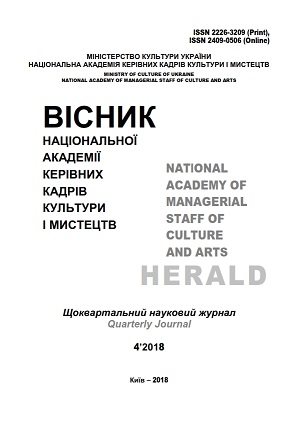Фактор соціальних мереж у завданнях захисту суспільного інформаційного образу закладів культури
Factor of Social Networks in the Protection of the Social Information Sector of Cultural Institutions
Author(s): Viktoriya Vasylivna Dobrovolska, Andriy Mykolayovych Peleshchyshyn, Volodymyr Anatolevich VusSubject(s): Media studies, Governance, Culture and social structure , Social Informatics, Sociology of Culture, ICT Information and Communications Technologies
Published by: Національна академія керівних кадрів культури і мистецтв
Keywords: Social networks; image; information image; cultural institutions; global networks; Internet;
Summary/Abstract: The purpose of the article. The purpose of the paper is to determine the main approaches to protecting the public information image of cultural institutions from possible social effects in social networks. The methodology of the research consists of a set of methods of analysis, synthesis, comparative, physical observation, classification and definition of the structure of objects. Scientific novelty is to determine the factor of social networks in the tasks of protecting the public information image of cultural institutions, such as archives, libraries, museums, clubs, etc. It has been established that despite a colossal positive impact on society's development and standard of living, social networks can also be a harmful environment for society. The following harmful influences and their significance for the information image of cultural institutions in society are identified. It has been established that for a number of reasons, cultural institutions are more objects than subjects of socio-communicative processes in global networks, which is, in fact, a major factor in the growth of risks. The concept of the transition to the subjective, socially active activity of cultural institutions in social networks, the essence of which should be the creation and placement of socially useful content in social networks, for which there is a tangible demand, is proposed. Based on the subjectivity of cultural institutions, two main classes of tools for protecting against harmful effects are identified: legal and informational. For each of them, features, advantages and disadvantages are defined. Possible types of information resources that can be used in such activity are offered. Conclusions. Cultural institutions should become one of the important factors in the formation of the informational space in the national and global dimensions, while conducting its activities taking into account possible threats of informational character and, accordingly, building an active strategy for the formation of their own information image in social networks.
Journal: Вісник Національної академії керівних кадрів культури і мистецтв
- Issue Year: 2018
- Issue No: 4
- Page Range: 132-137
- Page Count: 6
- Language: Ukrainian

